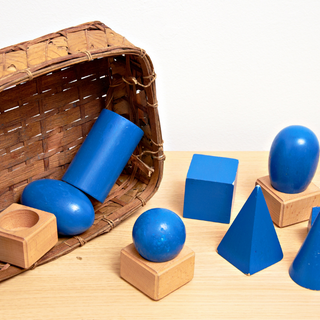
This sensorial geometry lesson is designed for 6 to 12-year-old children to introduce them to 3-dimensional shapes like a cube, a pyramid, a sphere, etc using Montessori geometric solids.
What are Montessori Geometric Solids?
The sensorial curriculum in Montessori education helps to use and enhance a child’s senses in their learning, forming concrete ideas from the abstract in their environments. There is clear evidence in one book written by Dr. Maria Montessori: Psychogeometry.
“We do not, therefore, offer material for the clear and concrete demonstration of what is taught in an abstract fashion in most schools. We simply offer geometric shapes, in the form of material objects, which have a relationship with each other. These shapes can be moved and handled, lending themselves to demonstrating or revealing evident correspondences when they are brought together and compared. This stimulates mental activity because the eye sees and the mind perceives things that a teacher does not know how to convey to an immature and inactive mind. Mental processes that are apparently premature and far advanced for the child’s age, thus become possible.”
Geometric solids in Montessori are 3-dimensional shapes that help children learn about different shapes that exist in their surroundings by touching them.
There are 6 basic geometric solids: sphere, cone, cube, cylinder, pyramid, and rectangular prism.
Each of these shapes has unique properties that differ from the others. Thus, this video lesson allows the child to understand the forms and shapes of different geometric solids by touching them. For example, a cylinder has two circles and no edges, cubes have 6 faces (sides), spheres are round with no side, pyramids have a point on the top and a square base, and prisms have rectangular sides, etc.
Purpose of Introducing Montessori Geometric Shapes to the Child
- It helps in the development of stereognostic sense (which is the ability to perceive and recognize both the form and nature of objects through touch.)
- It helps a child to relate to the objects present in their surroundings.
- It helps in developing a child’s muscle memory, order, and concentration.
- It also enables the child to practice fine motor skills and hand-eye coordination.
- It prepares the child for more complex math work that lies ahead.
Control of Error
- Each shape is distinct visually.
How to Introduce Geometric Solids to the Child?
- Invite the child to the table holding the wooden geometric solids box and placing it in the top right corner.
- Tell them today we are going to learn about shapes.
- Now, take out one shape at a time or the most recognizable shapes, such as the sphere.
- By touching them, tell the child to see this has no edges or no sides. It is called a sphere.
- Place it on the working mat.
- Allow the child to touch, feel and observe for a while.
- Ask the child, “which shape is this?”
- Let the child answer.
- If the child answers it correctly, introduce them to the next shape and repeat the steps (4-8).
- If not, explain the shape again by touch and feel.
- Repeat steps 4-8 till all 6 shapes are introduced.
- Allow the child to explore the other solids in the basket.
Watch the video to learn the unique features of each geometric solid. Invite the child to learn how to recognize geometric shapes, as shown in the video.
This practical method is a fun and innovative way to help them get a better understanding of geometry concepts.
Related Sensorial Resources
For more math resources, click here.
Video Created by: Joanne Shango
Tags
- english language
- primary level
- sensorial





